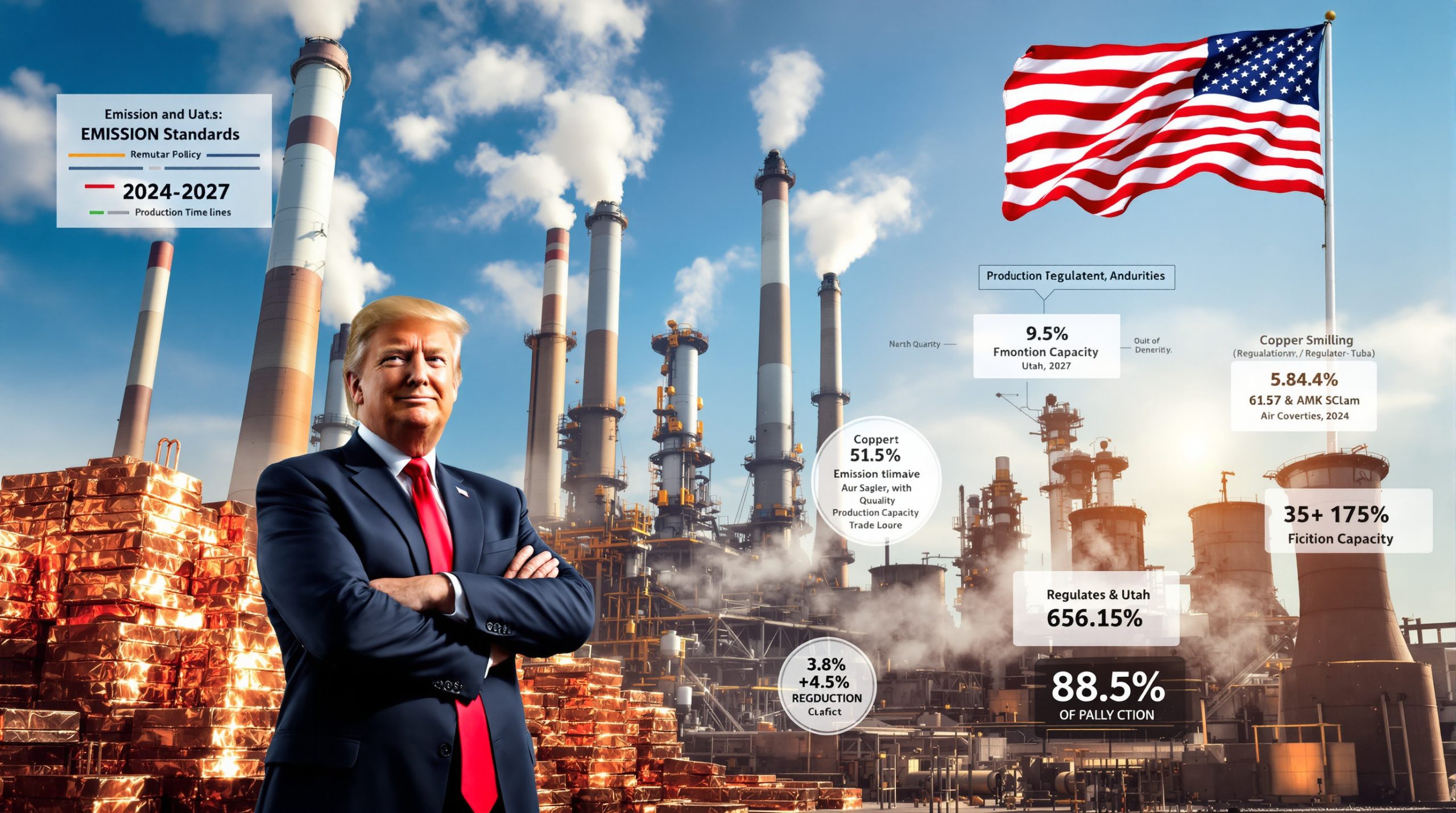What's Behind the Recent Copper Price Movements?
The ongoing trade tensions between the United States and China have created significant ripples across global commodity markets, with copper emerging as a key indicator of market sentiment. Recent price movements reflect the complex interplay between geopolitical developments and fundamental supply-demand dynamics in the copper market.
The 90-Day Tariff Pause and Market Response
Copper prices on the London Metal Exchange (LME) dropped 0.4% to $9,536 per metric ton as of May 16, 2025, while the Shanghai Futures Exchange (SHFE) copper contract eased 0.3% to 78,140 yuan ($10,851.12) per ton. Despite these daily fluctuations, the market has recorded weekly gains of 1.1% for LME copper and 0.6% for SHFE copper, indicating underlying resilience.
The recently announced 90-day tariff pause between Beijing and Washington initially sparked optimism among traders, causing a brief price rally. However, this enthusiasm has begun to wane as market participants evaluate the temporary nature of the agreement and its potential long-term implications for copper price prediction and trade flows.
"Chinese traders welcomed the 90-day pause initially, but the market remains uncertain about what will happen after this period expires," noted a Shanghai-based metals analyst. "This limited duration is creating a cautious approach to long-term positions."
Current Price Levels and Trading Ranges
Despite ongoing uncertainties, benchmark copper prices have maintained levels above the psychologically important $9,500 threshold. Chinese analysts project SHFE copper to trade within a relatively narrow band of 78,000-79,000 yuan per ton in the near term, reflecting a market caught between opposing forces.
The relative price stability masks significant underlying volatility. Daily trading volumes have increased by 15% compared to the previous month, suggesting heightened speculative activity and position adjustments as traders navigate the uncertain environment.
Technical analysts point to the $9,500 level as a crucial support zone, with multiple bounces from this threshold over recent sessions. Should prices break below this level decisively, further downside risk could materialize, potentially testing the $9,200-$9,300 range last seen in early 2025.
Why Are Traders Cautious About the US-China Agreement?
The copper market's measured response to the US-China tariff truce reveals deep-seated concerns about its durability and scope. Historical precedents have taught traders to approach temporary trade agreements with healthy skepticism.
Limited Duration of the Trade Truce
The 90-day pause agreement between Beijing and Washington covers most retaliatory tariffs but falls short of providing long-term certainty. This temporary nature has created a "wait-and-see" approach among many market participants, with futures positioning showing increased hedging activity rather than directional bets.
Chinese exporters have been observed "rushing cargoes out" during this window of opportunity, according to industry analysts. This behavior strongly suggests limited confidence in the agreement's longevity and reveals how market participants are adapting their strategies to navigate potential future disruptions.
The current situation bears similarities to previous trade tensions in 2018-2019, when temporary truces eventually gave way to renewed tariff implementation. This historical context helps explain why the copper market has responded with cautious optimism rather than exuberance to the current arrangement.
Potential New Copper Tariffs
Compounding market uncertainty is the fact that the United States has been considering new specific tariffs on copper imports since February 2025. These targeted measures could significantly disrupt global copper supply chains even if the broader tariff truce remains in place.
Industry sources indicate these proposed copper-specific tariffs could range from 10-25% on refined copper products, potentially redrawing the map of global copper supply chains. Major producers are already developing contingency plans for various tariff scenarios, including redirecting shipments to alternative markets.
"The possibility of copper-specific tariffs creates a multi-layered uncertainty for the market," explained a senior commodities strategist at a global investment bank. "Traders must now evaluate both the broader trade relationship and the potential for targeted measures affecting this specific metal."
What Supply Factors Are Affecting Copper Markets?
Beyond geopolitical considerations, fundamental supply dynamics are exerting significant influence on copper prices and US-China tariff truce discussions. Recent inventory changes and supply chain adjustments are creating additional complexities for market participants.
Warehouse Inventory Changes
SHFE-monitored warehouse copper stocks surged 34% week-on-week, reaching 108,142 tons as of the latest reporting period. This dramatic inventory buildup has occurred at a pace that industry analysts describe as "faster than expected," potentially adding downward pressure on near-term prices.
The inventory situation creates a more complex picture when viewed alongside LME warehouse stocks, which have remained relatively stable over the same period. This divergence between Chinese and international inventory levels suggests regional market imbalances that could create arbitrage opportunities for sophisticated traders.
Several factors may explain this rapid inventory accumulation:
- Chinese importers accelerating purchases before potential tariff implementation
- Seasonal stockpiling ahead of summer construction demand
- Production increases at major global mines outpacing consumption growth
- Strategic reserves building by state-affiliated entities
Global Supply Chain Adjustments
Chinese exporters are actively reconfiguring their supply chains in anticipation of potential future trade restrictions. This includes accelerating shipments during the tariff pause period and developing alternative routing options for refined copper products.
Supply chain managers are implementing what industry insiders call "tariff-resilient logistics," which involve:
- Diversifying export destinations to reduce reliance on any single market
- Establishing processing facilities in neutral third countries
- Creating flexible inventory positions across multiple jurisdictions
- Negotiating contract terms that include tariff risk-sharing provisions
These adaptations reflect a market increasingly structured around trade policy uncertainty as a permanent feature rather than a temporary disruption. The resulting inefficiencies add costs throughout the supply chain, ultimately affecting price dynamics in both the short and long term.
How Are Other Base Metals Performing?
The performance of copper should be evaluated within the broader context of the base metals complex, as correlated price movements often reveal underlying market drivers affecting industrial metals as a category.
Current Price Movements Across the Metals Complex
Recent trading sessions have shown consistent downward pressure across the base metals spectrum:
- Aluminum declined 0.8% to $2,468.5 per ton on the LME
- Zinc dropped 1.1% to $2,694.5 per ton
- Lead decreased 1.1% to $1,983 per ton
- Tin edged down 0.5% to $32,800 per ton
This synchronized movement suggests broader macroeconomic factors beyond copper-specific issues are influencing the metals complex. Manufacturing PMI data from major economies has shown slight contractions recently, indicating potentially softer industrial demand ahead.
Shanghai Futures Exchange Performance
Similar trends are evident on the Shanghai Futures Exchange:
- SHFE aluminum fell 0.5% to 20,130 yuan per ton
- Zinc dropped 1.1% to 22,500 yuan per ton
- Lead slipped 0.8% to 16,870 yuan per ton
These parallel declines across Chinese and international exchanges point to global factors rather than regional dynamics driving the metals market. Currency movements, particularly the strengthening U.S. dollar against the Chinese yuan, have added additional pressure on commodity prices denominated in USD.
Interestingly, copper has shown slightly better resilience than other base metals during this period of general weakness, suggesting its fundamental supply-demand balance may be tighter despite the recent inventory builds.
What's the Outlook for Copper Prices?
Market analysts are carefully evaluating both technical indicators and fundamental factors to project copper's price trajectory amid the current uncertainty.
Short-Term Market Projections
Technical analysts anticipate copper trading to maintain its current range despite day-to-day volatility. The $9,500 level represents a significant support zone that has held during recent testing, while resistance appears around the $9,700-$9,800 range.
Volume patterns indicate cautious positioning by institutional investors, with increased activity in options markets suggesting many traders are purchasing protection against significant price swings rather than taking outright directional positions.
"The current market environment favors range-bound trading strategies over directional bets," notes a senior metals strategist at a global commodities trading firm. "Until there's greater clarity on trade policy beyond the 90-day window, we expect copper to remain within its established trading band."
Inventory increases, particularly in Chinese warehouses, create natural resistance to significant price increases in the immediate term. However, strong physical premiums in certain regions indicate healthy end-user demand that could prevent substantial price declines.
Factors That Could Shift the Market Direction
Several key developments could potentially break copper out of its current trading range:
-
Trade policy developments beyond the 90-day pause: Any signals about permanent tariff reductions or escalations would likely trigger significant price movements.
-
Chinese infrastructure stimulus measures: Recent speculation about potential government support for construction and grid expansion could boost surging copper demand.
-
Global manufacturing PMI trends: Manufacturing data serves as a leading indicator for industrial metal demand, with readings from China, Europe, and the U.S. particularly influential.
-
USD-CNY exchange rate movements: Currency fluctuations directly impact the purchasing power of Chinese copper consumers and can shift apparent demand patterns.
-
Mine supply disruptions: Labor actions or operational issues at major copper mines could quickly tighten physical markets despite inventory builds.
The renewable energy and electric vehicle sectors continue to represent structural demand growth factors for copper, with projections suggesting these industries will require an additional 5 million tons of copper annually by 2030. This long-term demand narrative remains supportive despite near-term trade uncertainties.
How Does the Tariff Situation Affect Copper Producers?
The evolving tariff landscape creates both challenges and strategic opportunities for copper producers across different regions, forcing operational adaptations and financial hedging strategies.
Mining Company Considerations
Major copper producers face significant planning challenges amid trade policy uncertainty. Companies must simultaneously:
- Optimize production scheduling to align with potential tariff implementation dates
- Develop alternative customer relationships in non-affected markets
- Implement sophisticated hedging strategies to manage price risk
- Evaluate long-term capital investment decisions against shifting trade patterns
For integrated producers with operations spanning multiple countries, the current environment creates opportunities for strategic inventory positioning and transfer pricing optimization. These companies can potentially redirect concentrate and refined metal flows to minimize tariff exposure.
Regional pricing differentials have widened beyond normal arbitrage limits, creating profitable trading opportunities for producers with flexible logistics networks. The premium for copper delivered to Shanghai has increased to $85 per ton above LME prices, compared to historical averages of $45-60 per ton.
Regional Impact Assessment
The tariff situation affects copper-producing regions differently:
Latin American producers (particularly in Chile and Peru) are closely monitoring US-China relations, as they supply both markets and could face difficult allocation decisions if tariffs affect relative pricing. These countries account for approximately 40% of global copper mine production.
Australian producers potentially stand to benefit if Chinese buyers seek alternatives to U.S.-origin material. Australia's position as a major copper exporter without significant U.S. tariff exposure creates a potential competitive advantage in the Chinese market.
African copper belt operations in Zambia and the Democratic Republic of Congo are evaluating export destination diversification strategies. Historically focused on Chinese markets, these producers are exploring European and Middle Eastern buyer relationships as potential hedges against trade disruptions.
Chinese domestic producers face complex calculations balancing production costs against potential tariff protection. While import tariffs might create pricing advantages, these could be offset by increased costs for imported concentrate if retaliatory measures are implemented.
"Geographic diversification of both supply sources and customer relationships has become a strategic imperative rather than just a risk management tool," observed the CEO of a mid-tier copper producer during a recent earnings call.
FAQ About Copper Markets and Trade Relations
What caused the recent volatility in copper prices?
The combination of the US-China 90-day tariff truce announcement followed by uncertainty about longer-term trade policies has created market fluctuations. Additionally, rapid inventory increases in Chinese warehouses and concerns about potential new copper-specific tariffs have contributed to price movements. The market is essentially processing conflicting signals—positive short-term developments against uncertain long-term prospects.
How significant is the 34% increase in SHFE warehouse stocks?
The substantial week-on-week increase in copper inventories is notable for its rapid pace, which analysts suggest could place downward pressure on near-term prices if demand doesn't increase proportionally. This inventory surge represents approximately one week of Chinese copper consumption and suggests either deliberate stockpiling ahead of potential tariffs or a temporary mismatch between supply and demand. Historical patterns suggest inventory builds of this magnitude typically precede price weakness unless accompanied by strong consumption data.
What happens after the 90-day tariff pause expires?
Market uncertainty centers on what trade policies will be implemented after the temporary pause. Traders are particularly concerned about potential new copper-specific tariffs that the U.S. has been considering since February 2025. Possible outcomes include extension of the pause, permanent resolution of some tariff issues, or renewed escalation. Market participants are developing contingency plans for each scenario while closely monitoring diplomatic signals from both Washington and Beijing.
How are copper producers responding to the trade situation?
Producers are adjusting shipping schedules, inventory management strategies, and potentially revising production plans to navigate the uncertain trade environment. Chinese exporters in particular are accelerating shipments during the tariff pause period. Major mining companies are also engaging in more active hedging programs to protect margins against potential price volatility, with some reports indicating a 30% increase in producer hedging volumes compared to the previous quarter.
For investors looking to navigate this complex landscape, developing comprehensive investment strategies is essential. Furthermore, those seeking copper investment insights should monitor both technical indicators and fundamental developments in the U.S.-China trade relationship.
Disclaimer: This article contains market analysis based on current conditions and historical data. Future developments in trade policy, economic conditions, or supply-demand dynamics may significantly alter market outcomes. Readers should consult financial professionals before making investment decisions based on this information.
Want to Capitalise on Major Mineral Discoveries Before the Market?
Discovery Alert's proprietary Discovery IQ model provides real-time notifications when significant mineral discoveries are announced on the ASX, giving you a crucial edge in both short and long-term investment opportunities. Visit the Discovery Alert discoveries page to see historic returns from major mineral finds and start your 30-day free trial today.




